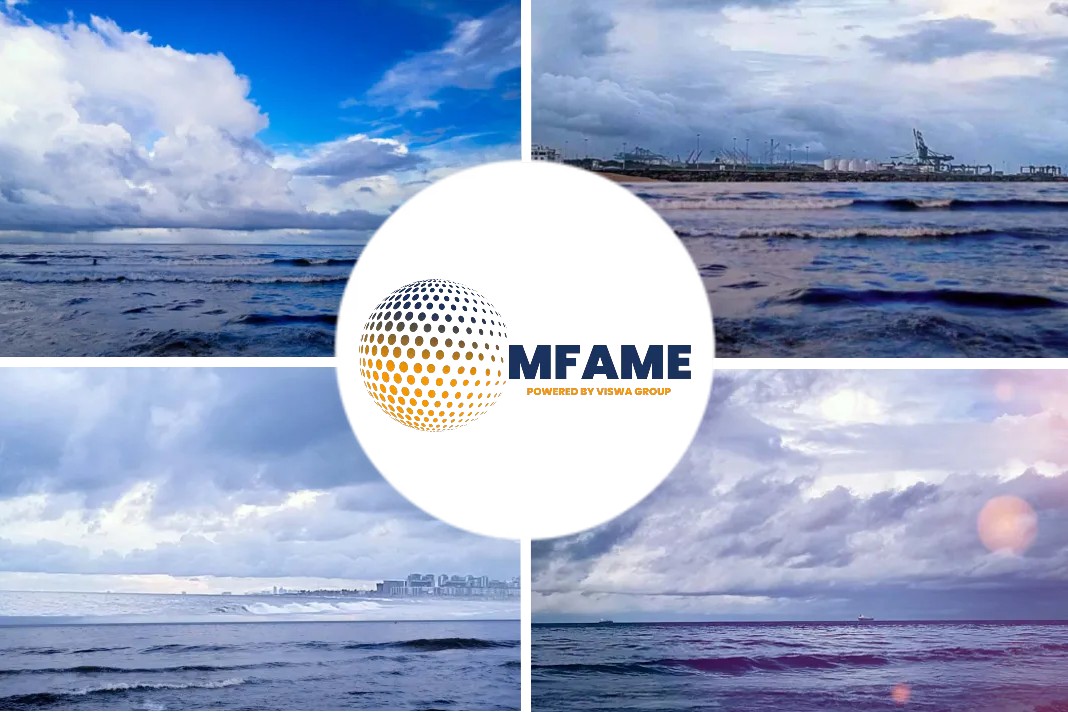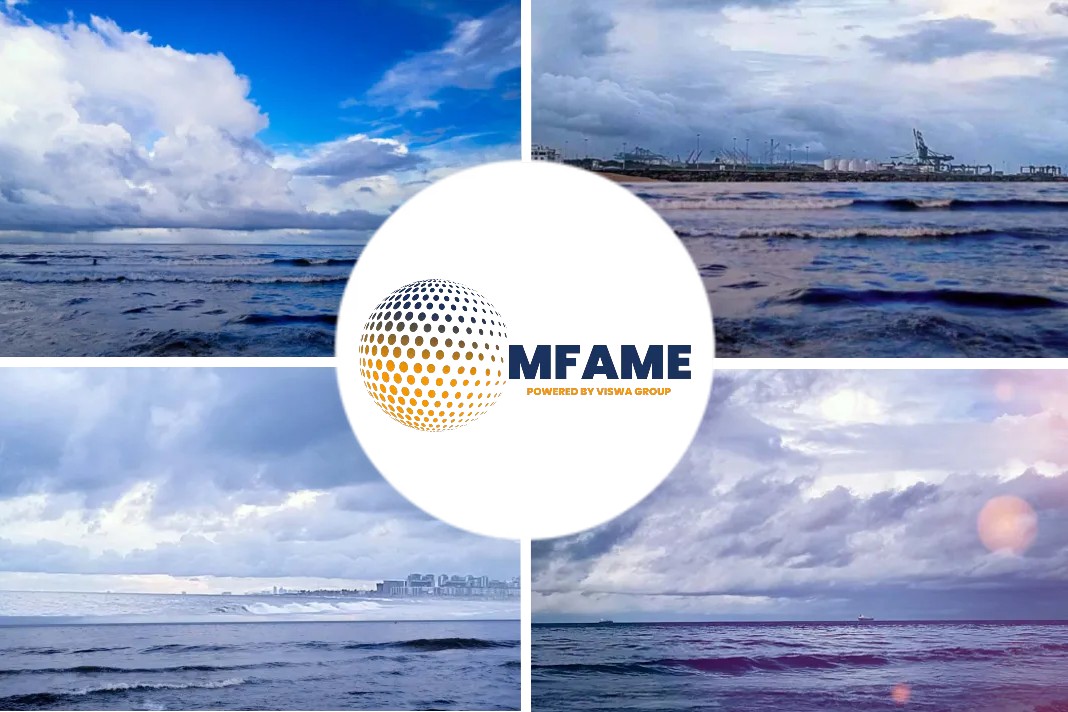- As the first of CMA CGM’s nine 400-m long, 61-m wide LNG-fuelled container ships, CMA CGM Jacques Saadé is carrying a heavy burden, both commercially and technically.
- The vessel departs from Singapore with a record 20,723 full containers on its maiden voyage – an 84-day round trip on the Asia-Europe route.
- The ultra-large container ship (ULCS) will demonstrate the environmental virtues of operating on LNG, showcasing the technical triumph of its cryogenic engineering.
- The 18,000 m3 of LNG on board, enough for two months sailing, is contained in a single membrane fuel tank that was designed into the structure of the ship.
- In fact, as CMA CGM explains, ‘the vessel is built around the tank.’
CMA CGM Jacques Saadé, world’s largest LNG-fuelled ship is technical triumph, writes Selwyn Parker, for the Riviera.
Features of the ship
Built with massive membrane fuel tanks and low-pressure, Otto-cycle engines, CMA CGM’s 23,000-TEU flagship and its eight sister vessels will operate on LNG to cut greenhouse gas emissions.
Who is the designer?
Designed by French cryogenic cargo containment engineering firm GTT, the tank has an internal stainless coating that resists the temperatures of -161°C required to keep LNG in its liquid state. It is also wrapped in two layers of insulation and a second membrane for safety and avoidance of gas loss while high-technology sensors monitor the condition of the tank in real time.
Despite its impressive volume, GTT says “size was not the major challenge.”
Classical tank capacity
In a briefing for Container Shipping & Trade, the French group says “For decades we have been used to designing huge LNG tanks for LNG carriers (LNGCs) where a classical tank capacity is about 40,000 m3. For the largest projects we have reached 55,000 m3. The 18,600-m3 membrane tank on CMA CGM Jacques Saadé relies on the Mark III technology that has already been installed on more than 300 LNGCs.”
“The challenges we had were linked to defining the functionalities required for such a new product. The shape of the tank was specifically developed to optimise the use of space and to reduce weight so that cargo capacity could be maintained. (The vessel has a capacity of 23,000 TEU.) Also, special care was taken in terms of managing boil-off gas [where] the thickness of the insulation was critical.”
Commercial and environmental reasons
The group’s president and chief executive Rodolphe Saadé has nailed his colours to the mast of LNG for sound commercial and environmental reasons. Apart from the fact the fuel burns much cleaner than traditional fossil fuels, CMA CGM has concluded that LNG makes sense for the bottom line, mainly because the vessel’s low-pressure, Otto-cycle engines will have a long working life.
Developed specifically for the ULCS by WinGD, they are extremely versatile and fuel flexible. As WinGD vice-president for research and development Dominik Schneiter explained in a release, the power plants are not limited to burning LNG. “These engines can be adapted for any of the potential sustainable fuels of the future [which] makes them an asset for a long time to come.”
Operating on LNG as compared with HFO, CMA CGM expects the ULCS will be able to reduce CO2 emissions by up to 20%, virtually eliminate SOx and particulate matter and cut NOx by 85%.
Energy Efficiency Design Index (EEDI)
In addition, the Energy Efficiency Design Index (EEDI), which measures the environmental footprint of a vessel, is improved by 20% compared to a conventional vessel.
The French container shipping giant is such a firm believer in the merits of LNG that by 2022 it will have 20 LNG-fuelled vessels in service. This includes CMA CGM Jacques Saadé and its eight sister vessels under construction at China State Shipbuilding Corporation yards, Jiangnan Shipyard and Hudong-Zhonghua Shipbuilding.
Drop-in fuels in the future
In the near future, WinGD sees fossil LNG being steadily replaced by ‘drop-in’ fuels bio-LNG and carbon-neutral LNG, probably produced by wind and solar power. This is why the group has faith in the longevity of the internal combustion engine, predicting it will play a major role in merchant shipping beyond 2050. By then, the engines on CMA CGM Jacques Saadé will almost certainly not be burning fossil-based fuels.
Classification of the engines
Bureau Veritas, which worked on the classification of the engines, believes biofuels are just around the corner. In its latest magazine, the society says “Completely compatible with modern ship engines and carbon-neutral when produced sustainably, biofuels are the unsung alternative fuel source sitting right under shipowners’ noses,” arguing that the marine industry has been slow to adopt them. “Less than 1% of the global fleet currently runs on biofuels despite increased production and availability in Europe, North America and Asia.”
Problems in terms of certifiably sustainable production
However, Bureau Veritas concedes that problems remain in terms of certifiably sustainable production and concerns that there will never be enough volume to fuel more than 30%, at best, of the global fleet. Despite the challenges, it is container ships that are leading the charge in carbon-neutral fuels because of pressure from their ultimate clients. “Cargo owners are increasingly requesting that shipowners use cleaner fuel,” notes the class society.
Total’s supplies
Total will supply about 270,000 tonnes a year of fossil LNG on a 10-year contract to fuel CMA CGM’s nine new 15,000-TEU container ships. The French energy giant’s bunkering business, Total Marine Global Solutions (TMGS), will provide fuel for the vessels at CMA CGM’s headquarters at Marseille-Fos, Rotterdam and in Singapore.
TMGS also holds an even larger contract – 300,000 tonnes per year – with CMA CGM to supply CMA CGM Jacques Saadé and its sister ships over a 10-year period.
What’s beyond CMA CGM contracts?
Looking beyond the CMA CGM contracts, Total sees these new supply chains as a vehicle to expand the use of LNG as a marine fuel, particularly in the Mediterranean. Total has plenty of LNG on tap – it produces about 40M tonnes a year and claims a global market share of 10%.
CMA CGM Jacques Saadé embodies a mission for CMA CGM’s president and chief executive who said at its launch “We have taken a big step forward [but] we need to go further to build transport that is even more respectful of the environment.” To his credit, CMA CGM started on this path as early as 2005 when it began reducing CO2 emissions.
Cluster Maritime Francais
His group, with a fleet of 500 vessels, is a founding member of the Cluster Maritime Francais, the organisation of some 430 companies dedicated to a complete transition in terms of ecology and energy by 2050.
Working swiftly since the coalition was established in late 2019, a list of nine concrete projects has been drawn up including developing biofuels for different forms of transport, green hydrogen, expanding the use of biogas and synthetic gases, and replacing fossil fuels with green energy across the entire supply chain.
Path prediction processes
The bridge of this giant is bristling with innovations that will make the officers’ job easier. A system known as ‘path prediction’ processes critical factors such as the rate of turn, speed and helm so the master can anticipate the movement of the ship as it comes into berth.
There is also a ‘smart eye’ system that provides a visual of the vessel in its immediate environment, helpful during port operations. Augmented reality screens provide extra information about the ship’s movement, such as distance from the dock and transverse speed.
Underwater, CMA CGM Jacques Saadé is fitted with a Becker Twist rudder for reduced cavitation by optimising the water flow. As a bonus, CMA CGM claims the system will reduce CO2 emissions by 4%.
Engines for all reasons
WinGD pulled out all the stops for the lean-burning, diesel-cycle 12X92DF engines. With a maximum power rating of 63,840 kW, equivalent to 10 Airbus A380 jet engines, according to CMA CGM, these power plants are the biggest the group has built as well as the most powerful LNG-fuelled engines ever.
They emerged from WinGD’s best-selling X-DF dual-fuel, low-speed technology first unveiled in H2 2017. At last count, WinGD had a crammed order book for 320 of these engines, with 60 in operation. They have been adopted across the maritime spectrum, powering LNG carriers, gas-fuelled ULCS, Aframax shuttle tankers, and very large crude oil carriers.
Type approval
Type approval for the engine only came in late May 2020 after a long process because of the size and complexity of the engine.
Bureau Veritas marshalled a worldwide team of engine specialists to monitor each of the critical phases of the certification process.
“Progressive type-approval tests were necessary,” explains Bureau Veritas technical vice-president Olivier Cartier, citing how progress and refinements had to be measured and noted at each step of the way. “We remained confident that final certification at 100% of the power using gas as fuel was an achievable objective.”
Methane slip a problem?
- Methane slip remains a problem in LNG-fuelled engines, methane being the main component of LNG and a potent greenhouse gas, but WinGD is addressing it.
- In a paper presented at the Gastech virtual summit in September 2020, the manufacturer claims its second-generation X-DF technology reduces fuel gas consumption by 3%, liquid fuel consumption by up to 5%, and methane slip by as much as 50%.
Considering the first of WinGD’s low-pressure, low-speed, two-stroke dual-fuel engines entered service as recently as 2016, this is good going. For the technically minded, engineers worked on two main areas.
The first was their conviction that, based on a mountain of field data, an increase in the engine’s geometric ratio would boost thermal efficiency, both in gas and diesel modes. And second, they tackled the issue of unburned hydrocarbons, mainly in the form of methane.
However, the engines on CMA CGM Jacques Saadé and its eight sister ships are of a different order altogether. Although not quite a giant experiment, they take WinGD’s low-pressure concept a big step further.
Did you subscribe to our daily newsletter?
It’s Free! Click here to Subscribe!
Source: Riviera

















